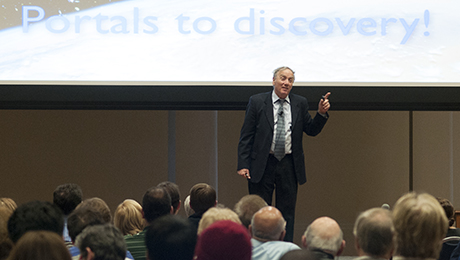By James Irwin
Scientific discovery can be tricky. Even Albert Einstein’s theory of general relativity has been tested over time: first it was right; then it was wrong; then he removed what was wrong; then the item he removed became an accepted explanation for a major breakthrough more than 40 years after his death.
Einstein and other notable minds—among them Charles Darwin and Linus Pauling—made some serious mistakes during their careers en route to their discoveries. Those gaffes were the topic of Thursday’s Frank Howard Distinguished Lecture, featuring astrophysicist Mario Livio and hosted by the School of Engineering and Applied Science. An endowment fund established in 1952 by former George Washington University trustee Frank A. Howard, DSci '61, supports lectures in engineering and allied subjects. Dr. Livio’s book, the New York Times’ bestseller “Brilliant Blunders,” explains the errors made by some of history’s most accomplished scientific minds en route to their achievements.
“I wanted it to be comforting to the rest of us that even some of the most brilliant luminaries have made some serious blunders,” Dr. Livio said. “We’re told that progress in every creative enterprise is a direct march from A to B and nothing could be further from the truth. Progress is full of lots of false starts and blind alleys. That’s how it’s achieved.”
The world’s most celebrated scientists have been no exception. “Brilliant Blunders” features five men—William Thompson (Lord Kelvin) and astronomer Fred Hoyle join Einstein, Darwin and Pauling in its pages—and focuses on evolution, weaving together their accomplishments and miscues.
A month into his project, Pauling—a distinguished biochemist who won two Nobel Prizes during his career—turned in a DNA model that defied almost every law of basic chemistry. It was a spectacular failure, wrong on every level.
In advancing his idea of natural selection, Darwin made a serious error in assuming that a popular theory of the time, blending heredity, was correct. Blending heredity held that characteristics of the mother and father are mixed, like paint, in their offspring. That went against Darwin’s entire idea of natural selection, Dr. Livio said.
“Imagine you have a population of a million butterflies; they’re all white, and there is one that is black,” he explained. “Imagine that black gives you an advantage. In Darwin’s theory of natural selection this would mean, eventually, the whole population would turn black. But in blending heredity the black butterfly mates with the white butterfly to create a gray butterfly, and black is gone forever.”
Darwin's mistake occurred during his most notable discovery. Pauling’s followed his greatest accomplishment. Shortly after correctly proposing the alpha helix model for proteins, the chemist went to work on predicting the structure of DNA. In a race with his rival, W.L. Bragg, and a couple of unknown molecular biologists, James Watson and Francis Crick, Pauling—who won two Nobel Prizes during his career—rushed his work. He staunchly believed that for something to replicate itself, it must be made of two parts that complement each other, yet, a month into the project, he turned in a triple helix model that defied almost every law of basic chemistry, including Erwin Chargoff’s rule that in DNA, the ratios of the four constants—adenine to thymine and guanine to cytosine—must be equal.
“You should allow for the possibility of breakthroughs and for serendipity,” Dr. Livio said. “You may make a blunder, but occasionally you will get a breakthrough. Those are what I call 'brilliant' blunders."
It was a spectacular failure. Within a few years Watson and Crick would correctly hypothesize the double helix model for DNA, in accordance with Pauling’s original belief in a two-part, harmonious structure for replication.
“His model was wrong on every level,” Dr. Livio said, “and this was the greatest chemist in the world.”
As for Einstein, his mistake was he didn’t trust his instincts. In formalizing his theory of general relativity, he added a cosmological constant as a counterbalance to gravity, using it to explain why gravity didn’t cause the universe to collapse in on itself— “a repulsive force, so everything is in equilibrium,” Dr. Livio explained. After Edwin Hubble and Georges Lemaître discovered the universe was expanding, not static, Einstein rationalized he no longer needed to include this constant. Gravity, he thought, simply acted as a decelerating agent that slowed natural expansion.
Image

|
| Albert Einstein introduced, and later removed, a cosmological constant in his theory of general relativity. |
Einstein removed the cosmological constant from his equation, referring to it as the biggest blunder of his life. In 1998, observations of a distant supernova showed the universe was not only expanding, but accelerating in its expansion. The now-accepted explanation: dark energy, best described by the term Einstein hypothesized and later removed.
“His mistake was not to put that term in; his mistake was to take it out,” Dr. Livio said. “Some people are just so smart that even when they think they’ve made a mistake it’s actually brilliant.”
That theory of discovery coming from mistakes wove its way throughout Dr. Livio’s lecture.
“You should allow for the possibility of breakthroughs and for serendipity,” he said. “You may make a blunder, but occasionally you will get a breakthrough. Those are what I call ‘brilliant’ blunders. Sometimes you are looking to create a medication for tuberculosis, and you find something that works on depression. That’s how it works. Scientific ‘brilliant’ blunders can be portals to discovery.”


